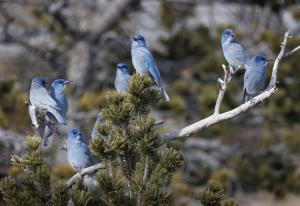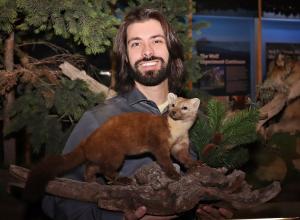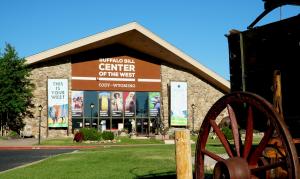
Study aims to enhance conservation endeavors for endangered species that depend on habitats found in both public and private lands.
— Corey Anco, Curator of the Draper Natural History Museum
CODY, WY, UNITED STATES, April 8, 2024 /EINPresswire.com/ — The Draper Natural History Museum at the Buffalo Bill Center of the West, along with research collaborators from the Bureau of Land Management, Museum of Wildlife and Fish Biology at the University of California, Davis, Northwest College, and U.S. Fish and Wildlife Service, were recently awarded $150,000 in funding from the Bureau of Land Management to study Pinyon Jays (Gymnorhinus cyanocephalus) in Wyoming’s Bighorn Basin.
The research project is funded by the Bureau of Land Management Wyoming Wildlife Program, which is focused on managing habitats for wildlife species that depend on public lands. The study proposes to characterize habitat use by Pinyon Jays across limber pine-juniper stands and compare Pinyon Jay movement with Greater Sage-Grouse foraging and breeding areas. The research team aims to parse out preferred Pinyon Jay habitat and identify differentiating features between Grouse and Jay habitats. Co-Principal Investigator (PI) Destin Harrell and Wildlife Biologist with the U.S. Fish and Wildlife Service says, “Separating areas where Sage-Grouse habitat may be improved from areas where Pinyon Jay habitat may benefit from conservation is a win-win opportunity for both species.”
About the size of an American Robin, the Pinyon Jay is a charismatic and gregarious bird, nesting and foraging in colonies that can range in size from a dozen to hundreds of individuals. Eric Atkinson, Associate Professor of Biology at Northwest College and Co-PI describes the Pinyon Jay as “stunning, raucous characters often heard well-before they are seen. Sometimes it seems like you hear laughing across the landscape.”
Pinyon Jays were recently petitioned to be listed under the Endangered Species Act, following an 85% decline over the past 50 years. Current projections predict populations will drop by another 50% within 20 years. Abel Guevara, Wildlife Biologist with the BLM Cody Field Office and Co-PI stresses, “Successful Pinyon Jay conservation efforts rely on the thoughtful integration of public and private land needs and use in the face of a changing climate. Bureau of Land Management lands play a central part in the Pinyon Jay’s story in northwestern Wyoming.”
Draper Natural History Museum Curator and Co-PI, Corey Anco, expressed his enthusiasm for the study, stating, “Our proposed research area in Wyoming’s Bighorn Basin is home to resident populations of Pinyon Jays that represent the species’ northern distribution. Yet, Bighorn Basin Pinyon Jay populations have never been formally studied. Geographically-specific information is vital to developing balanced and appropriate conservation and management strategies for Pinyon Jays.”
Project PIs will initiate fieldwork in the spring of 2024 to identify areas where Pinyon Jays forage and nest in Park County, Wyoming. The PIs will capture birds, place GPS tags on them to monitor their movements across the landscape for a year, and take a variety of samples to document morphology and condition. Co-PI Jason Riggio, Postdoctoral Scholar with the Museum of Wildlife and Fish Biology at the University of California, Davis, states, “If all goes according to plan, we’ll have gathered a location per day for an entire year in the life of a Pinyon Jay for up to 28 individuals, shedding light on the mysterious movements of this charismatic bird.”
This study is intended as a multi-year effort pending renewal of project funding.
Read more about the Pinyon Jay study on Wyoming Public Media at https://www.wyomingpublicmedia.org/natural-resources-energy/2024-04-05/wyoming-museum-leads-study-on-declining-pinyon-jay-population.
Want to help?
We want to hear from you! Citizen scientists are encouraged to participate in this project by monitoring backyard bird feeders and documenting observations of Pinyon Jays in the wild. The Draper Natural History Museum has developed datasheets to track Pinyon Jay observations. If you encounter Pinyon Jays at your feeders or on your travels, we would like your help! You can join this project and collect and share data with the PIs by requesting instructions and datasheets via email at [email protected].
How do I identify a Pinyon Jay?
We’ve got you covered! Learn to identify a Pinyon Jay by sight and sound on the All About Birds Pinyon Jay webpage: https://tinyurl.com/WYPIJA.
The Draper Natural History Museum is one of five museums under one roof at the Buffalo Bill Center of the West, located in Cody, Wyoming. The Center is a world-renowned Smithsonian Affiliate institution dedicated to preserving the rich heritage and history of the American West. For more information, please visit https://centerofthewest.org. Follow the Draper Natural History Museum @DraperMuseum on Instagram and @DraperNaturalHistoryMuseum on Facebook.
Ken Straniere, PR/Marketing Manager
Buffalo Bill Center of the West
+1 307-578-4137
email us here
Visit us on social media:
Facebook
Twitter
LinkedIn
Instagram
YouTube
TikTok
![]()
Originally published at https://www.einpresswire.com/article/701496452/study-of-pinyon-jays-in-wyoming-s-bighorn-basin-takes-flight





